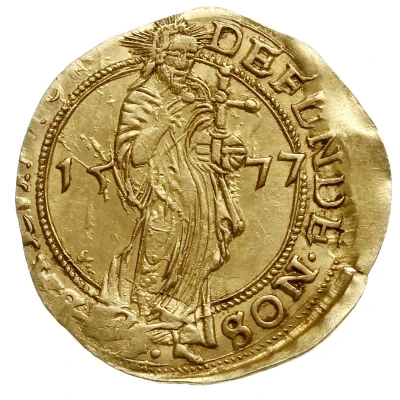


1 Ducat Siege coinage
1577 year| Gold | 3.50 g | 22 mm |
| Issuer | City of Danzig (Polish States) |
|---|---|
| King | Stephen Báthory (1576-1586) |
| Period | Danzig rebellion (1575-1577) |
| Type | Standard circulation coin |
| Year | 1577 |
| Value | 1 Ducat (1 Dukat) (56) |
| Currency | First Złoty (1577) |
| Composition | Gold |
| Weight | 3.50 g |
| Diameter | 22 mm |
| Shape | Round |
| Demonetized | Yes |
| Updated | 2024-10-07 |
| Numista | N#126323 |
|---|---|
| Rarity index | 97% |
Reverse
The emblem of Gdańsk in a shield, held by two lions with writing around it.
Script: Latin
Lettering: MONE•NO•AVR•CIVI•GEDANENS
Unabridged legend: Moneta Nova Aurora Civitas Gedanensis
Translation: New gold coin, city of Danzig.
Engraver: Gracjan Gonsalo
Comment
Note: The mint struck Ducaths at the same ‘Münzfuß’ as Hungary, meaning that they struck 56 coins out of a mark of 23,5 carat gold.
Unlike the other coins that were minted by Goebel or Talleman, the ducaths were minted by Gracjan Gonsalo, who was also responsible for counterstamping silver coins from e.g. Prussia.
There are 8 known types of this coin, despite the low survivability. As with other coins, the mintage remains unknown, but the amount of coins that survived until the present is estimated to be 6-120.
Kopicki 7402 - also restrikes
Punch 1 in gold
Ex.1
Price: 47 000 PLN
Picture: © WCN
Ex.2
Price:
Picture: © Jean Elsen & ses Fils
Punch 1 in Bronze - XIX century restrike
Price: 1 259 PLN
Picture: © GNDM
Kaleniecki str. 50, CNG 110, H.Cz. 602 (R5), Kop. 7402 (R7), Fr. 4
Interesting fact
One interesting fact about the 1577 Danzig Siege coinage 1 Ducat gold coin is that it was minted during a time of great turmoil and scarcity. The city of Danzig was under siege by the Swedish army, and the minting of coins was a way for the city to continue to function economically despite the surrounding conflict. As a result, the coin is a rare and valuable piece of history that serves as a testament to the resilience of the people of Danzig during a difficult period.



